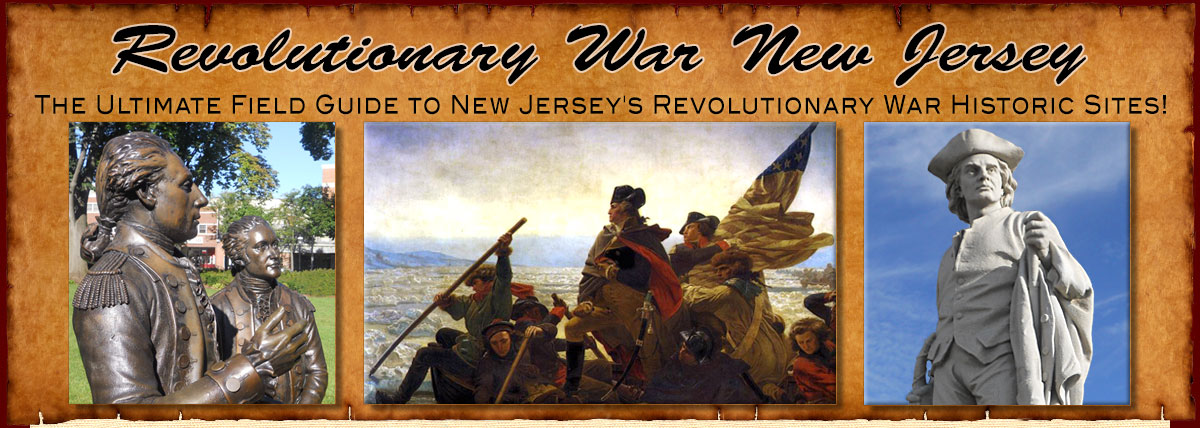

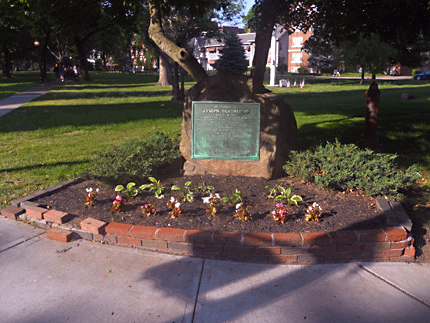
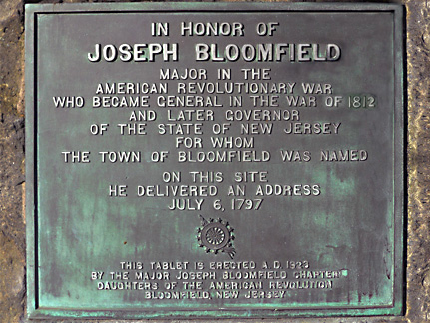
Joseph Bloomfield Boulder Monument
Town Green
Corner of Broad St. and Liberty St.
Map / Directions to the Joseph Bloomfield Monument
Map / Directions to all Bloomfield Revolutionary War Sites
Joseph Bloomfield
Joseph Bloomfield was born in Woodbridge, NJ, in 1753. During the Revolutionary War, he was an officer in the Third New Jersey Regiment, beginning as a Captain and rising to the rank of Major. He also served for a time as the Judge Advocate of the Northern Army. [1]
At the Battle of Brandywine on September 11, 1777, a musket ball pierced through his left arm, setting his coat and shirt on fire. After taking several months to recover from his wounds, he returned to active service and fought at the Battle of Monmouth on June 28, 1778. [2]
Joseph Bloomfield had a very successful career after the war ended. He served as the Attorney General of New Jersey from 1783-1792, as the Mayor of Burlington from 1795-1800, as the Governor of New Jersey from 1801-1812, as a Brigadier General in the War of 1812, and in the House of Representatives from 1817-1821. [3]
Joseph Bloomfield was a lifelong opponent of slavery, and he served as president of the New Jersey Society for the Abolition of Slavery. His father, Moses Bloomfield, was also an activist for abolition; he held anti-slavery meetings in his Woodbridge home where Joseph was born. [4]
Joseph died Oct. 3, 1823, and he is buried in St. Mary's Church Cemetery in Burlington.
The Township of Bloomfield was formed in 1812, and named in Honor of Joseph Bloomfield
In 1812, the township of Bloomfield was created from a portion of Newark and named in honor of Joseph Bloomfield. [5] However, the origins of the township's name actually date back to sixteen years earlier: in 1796, a group of local Presbyterians began building a church, and they named themselves the "Presbyterian Society of Bloomfield" in honor of Joseph Bloomfield.
On July 6, 1797, Joseph Bloomfield paid a visit to the society, and delivered a speech to them at the site commemorated by the boulder monument on the Town Green. After making his speech, Joseph made a donation for the "purpose of assisting them in building their new church." The church was completed in 1800 and called the First Presbyterian Church of Bloomfield, and later referred to as "Old First." [6]
When the township was formed In 1812, it also took the name Bloomfield.
The church building still stands and is shown in the photos below. It is located about three-tenths of a mile north of the boulder monument, at the other end of the Town Green, and is today known as the Presbyterian Church on the Green.
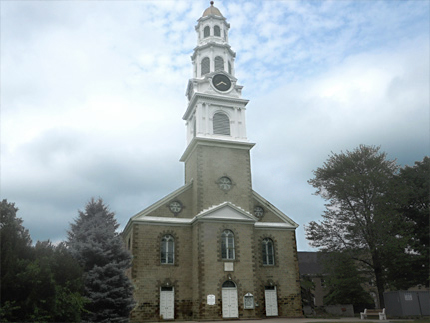
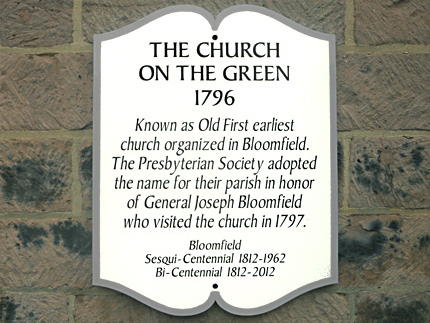

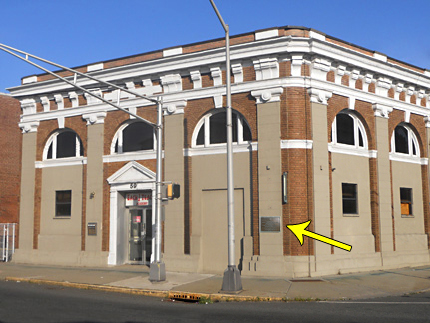
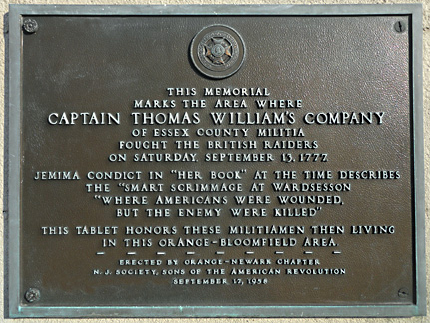
Captain Thomas Williams' Company Plaque
59 Dodd St.
Map / Directions to the Captain Thomas William's Company Plaque
Map / Directions to all Bloomfield Revolutionary War Sites
This plaque commemorates Captain Thomas Williams' company of Second Regiment of the Essex Company Militia, [7] Williams' company fought British troops in this area, known as Watsessing, on September 13, 1777, during the later part of the Battle of Second River. Second River was the name of Belleville at that time; a detailed account of the whole Battle of Second River can be read on the Belleville page.
The plaque references the writings of Jemima Condict to describe the events of the Battle of Second River at Watsessing. Condict was a local woman who kept a diary of her experiences during the Revolutionary War, that was published a century and a half later in 1930. Her diary entries give a view into the experiences of the Essex County residents during this time.
The quote from Jemima Condict on the plaque is a condensed version of what she actually wrote. The original text of her diary entry appears below.
Note that Jemima's spelling, capitalization, and punctuation have been left uncorrected and unmodernized, including her spelling of Watsessing as "wadsesson." Note also that "Regulars" refers to British soldiers.
"September ye 12 1777 On Friday there was an Alarm our Militia was Calld; The Regulars come over into elsabeth town Where they had a Brush With a Small Party of our People; then marched Quietly up to Newark; & took all the Cattle they Could. there was five of the Militia at Newark. they kill'd Samuel Crane and took Zadock; & Allen heady; & Samuel freman Prisoners, one out of five run & escapt. They went directly up to Second River & on Saturday morning marched up towards wadseson. our People atackted them there, Where they had a Smart Scurmage. Some of our people Got wounded there; but I do not Learn that any was Killed. there was Several kill'd of the regulars but the Number is yet uncertain." [8]
Both Jemima Condict and Captain Thomas Williams are buried at the First Presbyterian Church Cemetery in Orange.

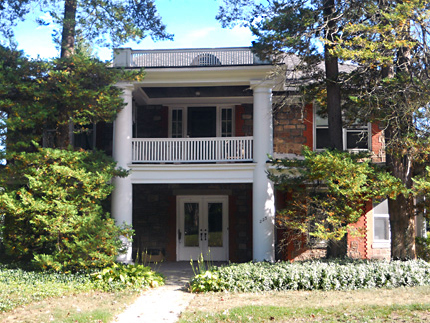
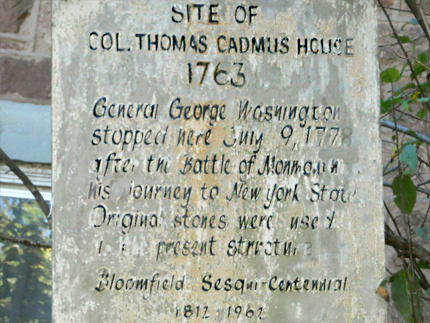
Lt. Col. Thomas Cadmus House
223 Ashland Ave.
Map / Directions to the Thomas Cadmus House
Map / Directions to all Bloomfield Revolutionary War Sites
This house is a private residence.
Please respect the privacy and property of the owners.
Lieutenant Colonel Thomas Cadmus (1736-1821)
Thomas Cadmus (1736-1821) served as a Lieutenant Colonel in the Essex County militia during the Revolutionary War. He is known to have commanded a battalion of New Jersey militia during the defense of New York in the summer of 1776, and he was later at the Morristown encampment in the winter of 1779-1780. [9]
After the war, Cadmus was a prominent local citizen. [10] He laid a cornerstone of the Bloomfield Presbyterian Church in 1797, and took part in the ceremonies for the speech given by Joseph Bloomfield described in the Joseph Bloomfield Monument entry above. [11]
George Washington is Believed to have Stopped at Thomas Cadmus' House in 1778. [12]
On June 28, 1778, General Washington and the Continental (American) Army won an important victory at the Battle of Monmouth. Four days later, they marched to New Brunswick where they remained until July 7. They then marched north through New Jersey; on July 9 they arrived at Newark, which then included what is now Bloomfield.
The following day, the Continental Army moved further north, where Washington visited Great Falls of Paterson with Alexander Hamilton and General Lafayette, and then arrived at the Hermitage in Ho-Ho-Kus where Washington made his headquarters for five days. [13]
Lt. Col. Cadmus is buried in Bloomfield Cemetery. (See the Bloomfield Cemetery entry below.)

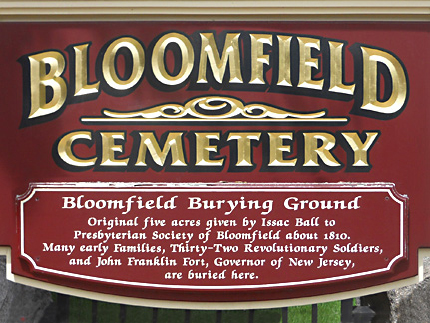
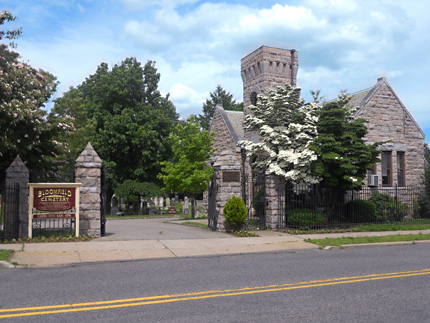
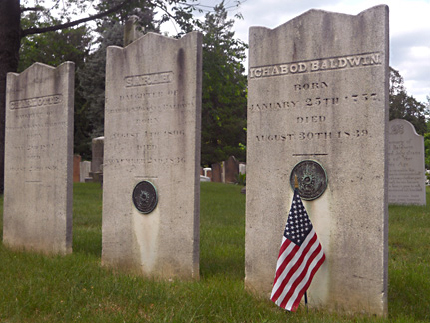
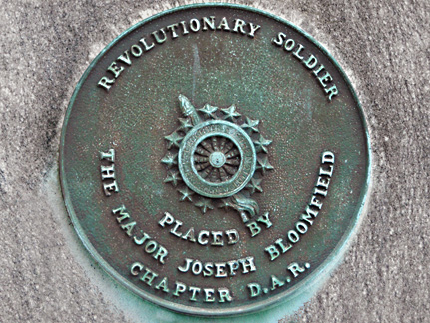
Bloomfield Cemetery
383 Belleville Ave.
Map / Directions to the Bloomfield Cemetery
Map / Directions to all Bloomfield Revolutionary War Sites
Bloomfield Cemetery is the resting place of thirty-two Revolutionary War soldiers: [14]
David Baldwin (1748-1810)
Ichobod Baldwin (1757-1839)
Jesse Baldwin (1754-1805)
Joseph Baldwin (1763-1821)
Linus Baldwin (1759-1836)
Samuel W. Baldwin (1763-1817)
Simeon Baldwin (1748-1808)
Zopher (Zophar) Baldwin (1740 - ?)
Joseph Ball (1734-1805)
Thomas Cadmus (1736-1821)
John Collins (1754-1806)
Joseph Crane (1750 -1807)
William Crane (1757-1832)
Caleb Davis (1717-1783)
Joseph Davis (1754-1827)
Abijah Dodd (1757-1837)
Amos Dodd (1737-1811)
Isaac Dodd (1763-1804)
John Dodd (1761-1826)
Joseph Dodd (1759-1816)
Matthew Dodd (1761-1826)
Moses Dodd (1755-1839)
Isaac Harrison (1757-1823)
Aury (Aurey) King (1756-1846)
John E. Smith (1751-1848)
Amos Tompkins (1746-1819)
Bethuel Ward (1752-1830)
Jacob Ward (1739-1811)
Samuel C. Ward (1747-1814)
Samuel (L.) Ward (1754-?)
James Wharry (1762-1803)
Joseph Woodruff (1745-1806)
A map showing the locations of the soldiers's graves is available at the cemetery office.

1. ^ William S. Stryker, Official Register of the Officers and Men of New Jersey in the Revolutionary War (Trenton: Wm. T. Nicholson & Co., 1872) Page 67
Available to be read at Internet Archives here2. ^ Joseph Bloomfield; Mark Edward Lender and James Kirby Martin; Editors, Citizen Soldier: the Revolutionary War Journal of Joseph Bloomfield (Newark: New Jersey Historical Society, 1982) Pages 127-128, 136-137
3. ^ Biographical Dictionary of the United States Congress
• One demonstration of Bloomfield's political prominence is that, at various times, he had reasons to correspond with each of the first four Presidents of the United States: Washington, Adams, Jefferson, and Madison.
Some of these letters are available to be read at the Founders Online / National Archive website:
• Letters written by Bloomfield can be read here.
• Letters received by Bloomfield can be read here.4. ^ See the Moses Bloomfield House entry on the Woodbridge page of this website for more information about Moses Bloomfield.
5. ^ An act to set off and erect a new township from the township of Newark, in the county of Essex, Passed the 24th of January, 1812.
Reprinted in:
Laws of the State of New-Jersey (Trenton: Printed, for the State, by Joseph Justice, 1821)
Available to be read at Google Books here• For more information about the timeline of Bloomfield, including parts of it later being taken for Belleville, Montclair, and Glen Ridge, see:
John F. Snyder, The Story of New Jersey's Civil Boundaries: 1606-1968 (Trenton: Bureau of Geology and Topography, 1969) page 126
Available as a PDF on the State of New Jersey website here. (Note that although the information is on the page numbered 126 of the document, it is on page 128 of the PDF file.)6. ^ Rev. James Manning Sherwood, Rev. Stephen Dodd, Plea for the Old Foundations: a Sermon Doctrinal and Historical, Delivered at the Rededication of the Presbyterian Church of Bloomfield, N.J. on Sabbath Morning and Afternoon, Dec. 18, 1853 by Rev. James Manning Sherwood, Pastor of the Church, with an Appendix of Historical Memoranda (New York: M. W. Dodd, 1854) Pages 100-108
Available to be read at the Internet Archive here
▸ Note that a contemporary article about Joseph Bloomfield's speech ("Communication from Bloomfield," Sentinel [Newark], July 12, 1797) is reprinted on pages 105-106.7. ^ Although the plaque spells his last name "William," it is spelled "Williams" in the following sources for his military service. It is also spelled "Williams" in the Revolutionary War veterans plaque in the First Presbyterian Church Cemetery in Orange.
William S. Stryker, Official Register of the Officers and Men of New Jersey in the Revolutionary War (Trenton: Wm. T. Nicholson & Co., 1872) Page 419
Available to be read at Internet Archives hereThe Daughters of the American Revolution Genealogical Research System, where Cadmus is Ancestor # A126689
William H. Shaw, History of Essex and Hudson counties, New Jersey, Volume 1 (Philadelphia: Evans & Peck, 1884) Page 32
Available to be read at Google Books here8. ^ Jemima Condict, Jemima Condict, Her Book: Being a Transcript of the Diary of an Essex County Maid During the Revolutionary War (Newark, N.J., The Carteret Book Club, 1930) Pages 66-67
9. ^ Thomas Cadmus' military information was drawn from a number of sources, including:
William S. Stryker, Official Register of the Officers and Men of New Jersey in the Revolutionary War (Trenton: Wm. T. Nicholson & Co., 1872) Pages 35 and 354
Available to be read at Internet Archives hereThe Daughters of the American Revolution Genealogical Research System, where Cadmus is Ancestor # A018045
The Campaign of 1776 around New York and Brooklyn (Memoirs of the Long Island Historical Society, Volume III) (Brooklyn: Long Island Historical Society, 1878) Page 112, and Page 20 of the Documents section
Available to be read at the Internet Archive
▸Cadmus is mentioned in the narrative on Page 112,
and within the Orders of General Nathanael Greene for July 4, 1776, which are reprinted on Page 20 of the Documents section10. ^ Collections of the New Jersey Historical Society, Volume VI / Records of the Town of Newark, New Jersey (Newark: New Jersey Historical Society, 1864) Pages 171-172
Records that, "At an Annual Town Meeting, held at the Court House in Newark, April 8th, 1793," Thomas Cadmus was named one of the Overseers of the Highway.
Available to be read at Google Books here11. ^ Rev. James Manning Sherwood, Rev. Stephen Dodd, Plea for the Old Foundations: a Sermon Doctrinal and Historical, Delivered at the Rededication of the Presbyterian Church of Bloomfield, N.J. on Sabbath Morning and Afternoon, Dec. 18, 1853 by Rev. James Manning Sherwood, Pastor of the Church, with an Appendix of Historical Memoranda (New York: M. W. Dodd, 1854) Pages 103-105
Available to be read at the Internet Archive here12. ^ The Bloomfield Sesquicentennial sign at the house, placed in 1962, states that Washington was here on July 9, 1778.
• The area that now makes up Bloomfield was then part of Newark Township. (See Source Note 5 above)
The following two letters sent from George Washington on July 9, 1778 are marked as being sent from Newark. Nothing in either of the letters indicates exactly where in Newark he was writing from:“From George Washington to Lieutenant Colonel Francis Barber, 9 July 1778,” Founders Online, National Archives (http://founders.archives.gov/documents/Washington/03-16-02-0046 [last update: 2016-03-28]). Source: The Papers of George Washington, Revolutionary War Series, vol. 16, 1 July–14 September 1778, ed. David R. Hoth. Charlottesville: University of Virginia Press, 2006, p. 42.
“From George Washington to Major General Horatio Gates, 9 July 1778,” Founders Online, National Archives (http://founders.archives.gov/documents/Washington/03-16-02-0048 [last update: 2016-03-28]). Source: The Papers of George Washington, Revolutionary War Series, vol. 16, 1 July–14 September 1778, ed. David R. Hoth. Charlottesville: University of Virginia Press, 2006, p. 43.
13. ^ For more information, and accompanying source notes about the events mentioned in this paragraph, see the Manalapan, New Brunswick, Paterson, and Ho-Ho-Kus pages of this website.
14. ^ Names and dates drawn from the Revolutionary War Soldiers in Bloomfield Cemetery document/map available at the Bloomfield Cemetery office.
The document has the source credit, "Information taken from report copied, recorded and indexed by David R. Anderson in the Fall of 1979 entitled Bloomfield and Montclair Cemetery Inscriptions Before 1880"
I would like to thank Krista White, the Digital Humanities Librarian of the John Cotton Dana Library at Rutgers University - The State University of New Jersey. She took the time to locate, scan, and send me some documents which were used in my research for this page.